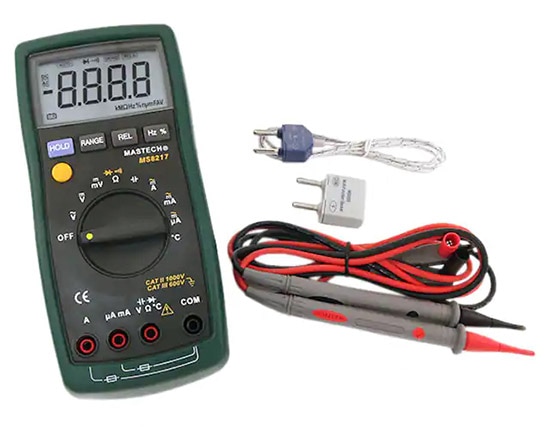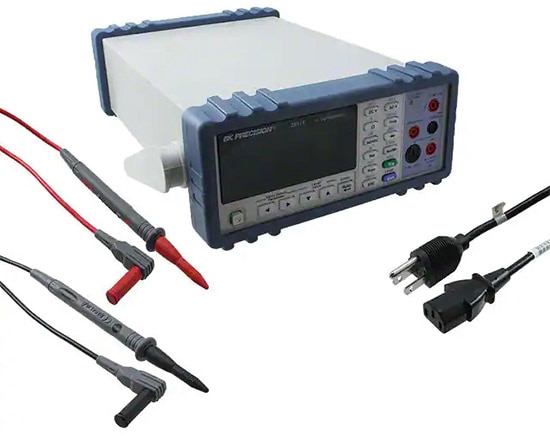制造商零件编号 480-001
DGTL MULTIMETER PRO DMM
Digilent, Inc.
 Image Source:
https://www.digikey.com/en/products/detail/digilent-inc/480-001/4090113
Image Source:
https://www.digikey.com/en/products/detail/digilent-inc/480-001/4090113
When starting out with electronics projects, a precise and reliable multimeter is one of the must-have tools that every maker should keep in their toolbox. This article explores what exactly a multimeter is, what functions they typically support, and what these handy measuring devices can be used for in the context of electronics projects and other tasks, such as household maintenance work.
A multimeter is a tool that combines multiple measuring instruments into a single device, allowing its users to measure an array of different electrical properties, typically in various supported ranges. Most multimeters support gauging electrical current, voltage, and resistance of circuits and components, eliminating the need to keep different measuring instruments for each task. Multimeters are not only practical because they combine multiple measuring tools in one handy device, but they are often more cost-effective than buying separate, dedicated measuring instruments, which becomes especially important when you begin to regularly work with electronics. Additionally, these tools are typically straightforward in their operation. You can generally choose between mobile devices that operate on batteries and don't need a fixed power supply or a lab multimeter that permanently resides on your bench.
While some more cost-effective models may only support measuring a circuit's voltage, AC and DC current, and resistance, more elaborate instruments can gauge additional properties such as capacitance, temperature, duty cycle, and inductance. Oftentimes, even the simplest of devices allows measuring continuity, which lets its users detect problems in a circuit, such as an open circuit or shorts.
As with choosing any tool, newcomers can quickly find themselves overwhelmed by a plethora of terms associated with various features and characteristics used when comparing multimeters. The most commonly used terms are easy to explain, and it's good to know how they impact a multimeter's operation and performance.
A multimeter's resolution refers to the smallest part of the scale a device can show. Manufacturers typically define this characteristic in dependence on the range used, as digital multimeters might support multiple measuring ranges such as up to 10 V or up to 100 V. For example, a device with a resolution of 1 mV on its 10 V scale can detect voltage differences in 1 mV increments. While some devices allow configuring of the resolution, higher resolutions typically take longer to calculate.
A multimeter's accuracy describes the device's overall accuracy in taking measurements. Typical consumer-grade digital multimeters have an accuracy of around 0.5%, meaning the value they measure may deviate from the actual value by 0.5% in either direction. However, you should remember that the accuracy drifts over time as the device moves out of calibration.
When used for measuring voltage, a multimeter's input impedance must be very high compared to the circuit under test. This prevents the gauging process from affecting the circuit and, thus, yields incorrect measurement results. The input impedance of most consumer digital multimeters is either one or ten megaohms.
When using a multimeter to measure current, the instrument's ideal resistance would be zero so as not to interfere with the circuit or the measuring results. However, in real-world situations, there will always be a slight resistance present caused by the circuit used to measure the current. Most digital multimeters, in addition, will use a shunt resistor and measure the voltage drop across that resistor to calculate the current. The combined voltage drop of that resistor and the rest of the circuit is referred to as the burden voltage.
A multimeter is any measuring instrument that can gauge various physical characteristics of a circuit. These devices can come in multiple shapes and sizes, ranging from cost-effective handheld beginner devices with acceptable accuracy to lab-grade bench-top instruments with superior accuracy that can easily cost thousands of dollars.
 Multimeters come in a large variety of different shapes and sizes. Some are small and portable, while others are more substantial and accurate. Image source:
https://www.digikey.com/en/products/detail/b-k-precision/2831E/2280305
Multimeters come in a large variety of different shapes and sizes. Some are small and portable, while others are more substantial and accurate. Image source:
https://www.digikey.com/en/products/detail/b-k-precision/2831E/2280305
Most multimeters can at least determine voltage, current, and resistance in circuits. Even the cheapest devices can measure continuity, letting users detect open and short circuits. More advanced models may include features such as impedance, capacitance, and temperature measuring, as well as logic detection, duty cycle, and frequency calculations.
It’s essential to keep a few fundamental characteristics in mind when choosing between multimeters, the key points being the device’s resolution, accuracy, input impedance, and burden voltage.